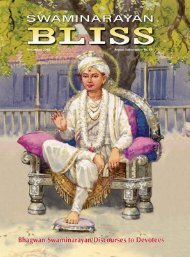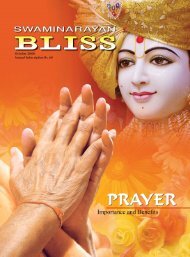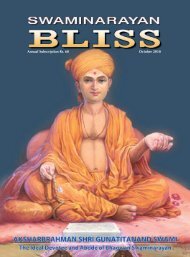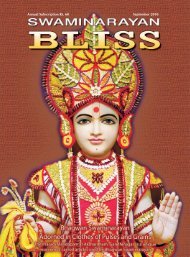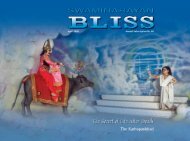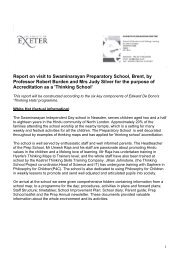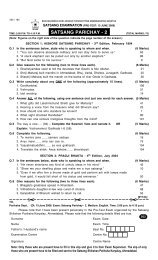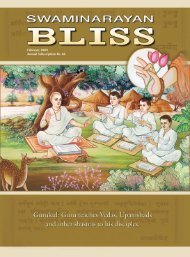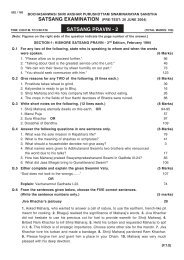August 2009 Annual Subscription Rs. 60 - Swaminarayan Sanstha
August 2009 Annual Subscription Rs. 60 - Swaminarayan Sanstha
August 2009 Annual Subscription Rs. 60 - Swaminarayan Sanstha
You also want an ePaper? Increase the reach of your titles
YUMPU automatically turns print PDFs into web optimized ePapers that Google loves.
AKSHARBRAHMAN:<br />
AS A SEVAK IN AKSHARDHÃM<br />
Maharshi Angirã explains the different<br />
functions of Aksharbrahman very clearly.<br />
As an abode Aksharbrahman upholds<br />
Paramãtmã and the muktas. Aksharbrahman<br />
also resides with a form within that very abode.<br />
Explaining this, Angirã says, ‘çÎÃØð ÕýræïÂéÚðU sïðá ÃØô‹Øæˆ×æ<br />
ÂýçÌçDïUÌÑ’ – ‘Divye Brahmapure hyesha vyomnyãtmã<br />
pratishthitaha’ (Mundaka Upanishad: 2/2/7).<br />
Aksharbrahman, the ãtmã of all, resides in<br />
divine Brahmapur, i.e. Akshardhãm. That too,<br />
with a form with divine hands, feet, etc. ‘×Ùô×ØÑ<br />
Âýæ‡æàæÚUèÚUÙðÌæ’ – ‘Manomayaha prãnashareeranetã’<br />
(Mundaka Upanishad: 2/2/7). He is complete with<br />
a divine mind, vital breath and body. The figure<br />
of his body is also beautiful. ‘çãUÚU‡×Øð ÂÚðU ·¤ôàæð çßÚUÁ¢<br />
Õýræï çÙc·¤Ü×÷Ð Ì‘ÀéUÖý¢ …ØôçÌáæ¢ …ØôçÌSÌÎæˆ×çßÎô çßÎéÑH’ –<br />
‘Hiranmaye pare koshe virajam brahma nishkalam,<br />
tacchubhram jyotishãm jyotistadãtmavido viduhu’<br />
(2/2/9). That very Aksharbrahman is in the form<br />
of a servant of Paramãtmã in that extremely<br />
illuminous and supreme Akshardhãm. It is always<br />
free of the three gunas – rajoguna, tamoguna<br />
and sattvaguna – unchangeable, and shubhram –<br />
beautiful in every way, extremely pure and the<br />
lustre of even the luminous. It is known as such by<br />
the wise. Therefore we should know it too.<br />
Thus, Angirã Muni has disclosed a unique<br />
form of Aksharbrahman. Then Angirã explains yet<br />
another important function of Aksharbrahman.<br />
AKSHARBRAHMAN: AS A BRIDGE<br />
Shaunak! All the functions of Aksharbrahman<br />
that we have seen so far are divine. Nevertheless,<br />
what I am about to say is something of great benefit<br />
to spiritual aspirants like us. It is extremely useful<br />
and therefore must be known. It is not easy to see,<br />
know or experience Aksharbrahman as the allpervasive,<br />
all-supporting cause of all. Nor will we<br />
be able to see, know or experience Aksharbrahman<br />
as Akshardhãm or as the servant of Paramãtmã in<br />
that Akshardhãm until we become brahmarup. The<br />
only way we can see, know and experience all of<br />
this is if Aksharbrahman himself, out of compassion,<br />
comes in human form before our very eyes and<br />
becomes like us and stays with us. Therefore, I will<br />
now explain the form of Aksharbrahman which<br />
is easily available to all. With these sentiments,<br />
Angirã says, ‘¥×ëÌSØñá âðÌéÑ’ – ‘Amrutasyaisha Setuhu’<br />
(Mundaka Upanishad 2/2/5). It is this very<br />
Aksharbrahman that is the bridge to immortality,<br />
i.e. moksha (liberation), and the attainment of<br />
Paramãtmã. Just as people cross large raging rivers<br />
easily by taking the refuge of a bridge, similarly<br />
by taking the refuge of Aksharbrahman spiritual<br />
aspirants cross the ocean of this life. This form of<br />
Aksharbrahman is known as the ‘guru’. That is why<br />
when it was time to describe the characteristics of<br />
the guru, Angirã clearly said that the guru should<br />
be ‘Ÿæôç˜æØ×÷’ – ‘Shrotriyam’, i.e. he should be realized<br />
in the essence of all the shastras, he should be 'Õýræï'<br />
– ‘Brahma’, i.e. Aksharbrahman himself, and he<br />
should be ‘çÙcÆU×÷’ – ‘nishtham’, i.e. he should have<br />
conviction in Paramãtmã. (Mundaka Upanishad:<br />
1/2/12)<br />
AKSHARBRAHMAN’S FOUR FUNCTIONS<br />
Looking carefully at this entire description of<br />
Aksharbrahman we can see four distinct functions.<br />
One being the all-pervasive, all-supporting cause<br />
of all. Bhagwan <strong>Swaminarayan</strong> has used the word<br />
‘chidãkãsh’ for this (Vachanamrut Gadhada I-46).<br />
The second, being the support of Paramãtmã and<br />
the countless muktas as an abode. For this, Bhagwan<br />
<strong>Swaminarayan</strong> uses words such as ‘Akshardhãm’,<br />
‘Brahmadhãm’, ‘Brahmapur’ (Vachanamruts<br />
Sarangpur 1, Gadhada I-63, Kariyani 8, etc.).<br />
Thirdly, being in the service of Paramãtmã within<br />
that Akshardhãm with a human-like form. Bhagwan<br />
<strong>Swaminarayan</strong> talks about this in Vachanamrut<br />
Gadhada I-21, ‘In its other form, that Akshar<br />
remains in the service of Purushottam Narayan.’<br />
The fourth form is, by the wish of Paramãtmã, to<br />
incarnate in human form to rid aspirants of their<br />
ignorance, to make them brahmarup, to develop<br />
<strong>August</strong> <strong>2009</strong> <strong>Swaminarayan</strong> Bliss 11



